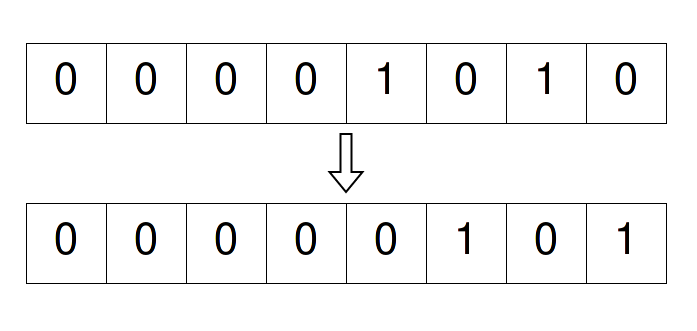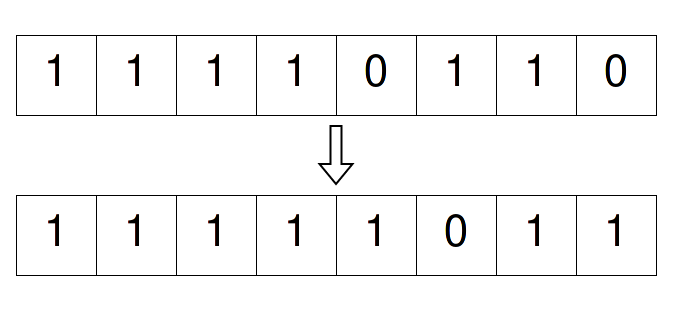
Open-Source Internship opportunity by OpenGenus for programmers. Apply now.
In this article, we have explained two approaches to find the Absolute value of Integer using Bitwise Operations namely Right shift, OR and XOR operations.
Contents
- Introduction
- Integers in binary
- Shifting bits
- XOR in binary
- Result
- A second approach
Introduction
If we define what's Absolute value, then it says that "The distance of some number from the zero is an Absolute Value".
Which means if there is some given number +/- N then the Absolute Value of this number should be N.
One way to find out the Absolute value of a number will be to check if the given value is negative or positive and if it's positive, then return n and if it's negative, then return n - 2*n.
Code for the above Example:
fn abs(n: i8) -> i8 {
if n > 0 {
n
} else {
(n - n) - n // Using this because,
// Above mentioned can overflow.
}
}
But, you see, this requires an if-else statement, and if we used binary operations to find Absolute Value, then one can avoid using if-else statements.
Note: we will be considering only 8-bit numbers here, but you can apply this method to others as well.
Just usesize_of(n) * 8to find out the number of bits for the data type you're using.
Integers in binary
I think if you're scrolling through this page, then you should already be familiar with how we represent integers in binary and how we know if a number is positive or negative but, to make sure that we're on the same page, we'll look at it once again.
There are two kinds of numbers one is signed and unsigned.
unsigned
- The range for
unsignednumbers goes simply from0 to 255and in binary0000_0000to1111_1111.
signed
-
But the range for
signednumbers goesfrom -128 to 127, and in binary, there are two ranges to make note of0 to 127->0000_0000to0111_1111-1 to -128->1111_1111to1000_0000
Yep!! It counts backward.
And Of course, we will be using only signed integers here.
Shifting Bits
The rule is to have a 1 bit (the most left one) in signed integers as a sign bit, when it's 0 then, consider the number to be positive and negative if the sign bit is 1.
Now, shifting bits to the left will do the same things for both positive and negative integers.
But when we right shift the bits then, a positive integer will have no issue and, there will be a 0 in the sign bit before and even after the shift.
But, when we right shift a negative integer then, it is necessary that we make sure to preserve the sign bit. So, there will be 1 present in the sign bit.
For Example:
Positive Number
Let's consider a number n = 10 and, now if we right shift it, then it should look something like the given diagram:

Negative Number
And for n = -10, it will look something like this:

And if we think about this, then this thing gives us a really good trick to use, which will let us know if the given value of a number is negative or positive. How?
Well, if we right shift a positive integer then the bit that gets added to the left is 0, and for negative integer 1.
And if we keep doing the right shift then every bit in any negative number should become 1 and every bit in any positive number should become 0.
Therefore:
negative number >> 7 should give
-1 (1111_1111).
positive number >> 7 should give0 (0000_0000).
XOR in Binary
Here we are going to learn a trick regarding XOR operation, which is a necessary part to make a decision when we will be calculating the Absolute Value.
So, doing XOR operation is simple, only know that:
- if the given two bits are different then, the output will be
1. - if the given two bits are same then, the output will be
0.
Now, let's try something where we consider some bits,
awhich, will be fixed to 1
Andbwhich, can be 1 or 0.
So, if we takeXORfor both 1 and 0 ofbwith a fixed bita:
Then,
0 ^ 1=1
1 ^ 1=0
So, we can conclude that for b, if
XOR'ed with a, it should act asnegation
that is,bit ^ 1=!bit
And if we did same thing but, now a is fixed to 0, we see that:
0 ^ 0=0
1 ^ 0=1
then this tells us that,
bit ^ 0=bit
And now, we can conclude that, if we take any number and XOR'ed it with a number where all bits are 1, then the result will be inverted version of the given number.
Example:
1 ^ 0b1111_1111equals to-2
Remember, we're considering i8
Finding Absolute Value
Well, time to apply it all, to calculate Absolute Value the solution we have here can be divided in three steps:
- Check if the number is negative or positive.
For this, we canright shiftthe bits for the ( total number bits - 1 ). And this is ourmask.
mask = n >> size_of(n) * 8 - 1
- Add
oneto the number if negative and Addzeroif positive.
Adding the mask will do this automatically.
n = n + mask
This step balances the number by filling the gap on the positive side of anyunsignednumber.
- Now, invert the whole number using
XORif negative.
Here also usingmaskshould do this automatically because mask can choose to invert if the number is negative.
Example Code:
fn abs(n: i8) -> i8 {
// 1st: right shift (sign check)
let mask = n >> 7;
// 2nd: Add the mask, `+` and `-` balance.
let n = n + mask;
// 3rd: Now, invert and return.
n ^ mask
}
Time and Space Complexity
Assume we have to find the absolute value of a N-bit number
Time Complexity: O(N)
as the bitwise operations right shift and XOR along with add operation take O(N) time.
Space Complexity: O(N)
as we have to maintain the mask which is the same size of the input value.
Another Approach
When I was looking at 'the above' algorithm, I thought I would try to find some other way of doing this, So, after some tries, I figured one out, and when I told @aditya about this, he asked me to add it here.
So, here we are.
The idea for this approach is simple.
Whenever we multiply two different numbers then we make sure the signs are right and we have some rules for that. And one of them is, if we multiply two negative numbers then the result of this product should be a positive number.
And our goal is to change the number to positive if it's negative and return the same number if it's positive.
One thing we already learned is that if we use Right Shift we get
-1fornegativenumbers and,0forpositivenumbers.
So, if we use n >> 7 and multiply it with n, we can get a positive number for a given negative number.
Something like if n = -12:
then,
(n >> 7) * n will produce 12 as a result.
But you see if n = 12:
then,
(n >> 7) * n will produce 0 as a result.
Yep! A problem!
So, now we need to find a way which will change our mask to 1, when n >> 7 is 0 and do nothing when it's -1.
Let's look at the binary representation of -1, 0 and 1.
-1 -->
1111_1111
0 -->0000_0000
1 -->0000_0001
Here, we can see that we have to change the Right most bit to 1 if it's 0 or else all bits should remain 1.
And OR ( | ) is the operator that we can use for this task.
OR operator
So, what OR operator does is that, it returns 1 if any of the given input is 1, and it returns 0 only if bits of both sides are 0.
Now, if we try OR on our mascots -1 and 0, with 1, we get the following result:
-1 | 1 -->
1111_1111
0 | 1 -->0000_0001
Their we go we got it.
Sum Up
Now, if we sum up all that, then again we have 3 Steps to do this:
- Check, if the given number
nisnegativeorpositive.
if_neg = n >> size_of(n) * 8 - 1
- Create
mask. For that take theORofif_negand1 (0000_0001).
mask = if_neg | 1
- Now take product of the
maskand the Numbernto get theAbsolute Value.
mask * n
Code Example
fn abs(n: i8) -> i8 {
let size = std::mem::size_of_val(n) * 8;
// 1st step: do the right_shift
let if_neg = n >> (size - 1);
// 2nd step: change to 1 if 0 else remain -1
let mask = if_neg | 1_i8;
// 3rd step: multiply and return
mask * n
}
Time and Space Complexity
Assume we have to find the absolute value of a N-bit number
- Time Complexity: O(N logN)
as the bitwise operations right shift and OR take O(N) time
but the arithmetic operation Multiplication has a theoretical limit of O(N logN). In practice, the Time Complexity of Multiplication is O(N2).
In practice, the Time Complexity of this approach is O(N2) while the theoretical limit is O(N logN).
- Space Complexity: O(N)
as we have to maintain the mask which is the same size of the input value.
With this article at OpenGenus, you must have the complete idea of Absolute value of Integer using Bitwise Operations.
